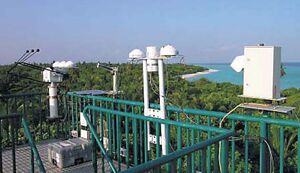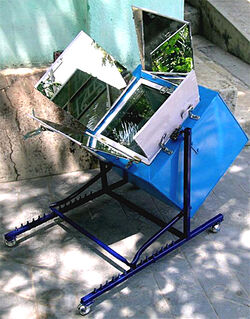Tom Sponheim (talk | contribs) (Created page with "{{CurrentNews|India}} *'''December 2009:''' "Sabarmati Central Jail is upgrading facilities and living and working conditions... the jail authorities are setting up an econom...") |
Tom Sponheim (talk | contribs) mNo edit summary |
||
| (4 intermediate revisions by the same user not shown) | |||
| Line 1: | Line 1: | ||
| + | {{GoogleTranslateLinks}} |
||
| − | {{CurrentNews|India}} |
||
| + | |||
| + | |||
| + | {{CurrentNewsLink|India}} |
||
*'''December 2009:''' "Sabarmati Central Jail is upgrading facilities and living and working conditions... the jail authorities are setting up an economical solar cooking system for its large kitchen to replace gas-guzzling conventional burners..." [http://www.ahmedabadmirror.com/index.aspx?page=article§id=3&contentid=20091118200911180225041569c610223§xslt=&pageno=1 Rs 40-lakh solar cooking system for city jail] from ''Ahmedabad Mirror.com''. |
*'''December 2009:''' "Sabarmati Central Jail is upgrading facilities and living and working conditions... the jail authorities are setting up an economical solar cooking system for its large kitchen to replace gas-guzzling conventional burners..." [http://www.ahmedabadmirror.com/index.aspx?page=article§id=3&contentid=20091118200911180225041569c610223§xslt=&pageno=1 Rs 40-lakh solar cooking system for city jail] from ''Ahmedabad Mirror.com''. |
||
| Line 65: | Line 68: | ||
*'''January 2006:''' Professor [[Ajay Chandak]] of [[Prince India|Promoters & Researchers In Non-Conventional Energy (PRINCE)]] led a workshop titled “Manufacturing Parabolic Solar Cookers and an introduction to renewable energy technologies.” Twenty people from eight states participated in the workshop, mostly renewable energy professionals. Mr. Chandak hopes that several of them will consider manufacturing parabolic solar cookers in their own states. Large community-size cookers, two meters or more in diameter, proved quite popular. These cookers can cook meals for 30-50 people. Smaller, family-side cookers were also shown, as were related technologies like solar food dryers. '''''Contact:''''' ''[[Ajay Chandak]], [[Prince India]]'' |
*'''January 2006:''' Professor [[Ajay Chandak]] of [[Prince India|Promoters & Researchers In Non-Conventional Energy (PRINCE)]] led a workshop titled “Manufacturing Parabolic Solar Cookers and an introduction to renewable energy technologies.” Twenty people from eight states participated in the workshop, mostly renewable energy professionals. Mr. Chandak hopes that several of them will consider manufacturing parabolic solar cookers in their own states. Large community-size cookers, two meters or more in diameter, proved quite popular. These cookers can cook meals for 30-50 people. Smaller, family-side cookers were also shown, as were related technologies like solar food dryers. '''''Contact:''''' ''[[Ajay Chandak]], [[Prince India]]'' |
||
| + | [[Category:India]] |
||
Revision as of 18:38, 19 October 2013
- December 2009: "Sabarmati Central Jail is upgrading facilities and living and working conditions... the jail authorities are setting up an economical solar cooking system for its large kitchen to replace gas-guzzling conventional burners..." Rs 40-lakh solar cooking system for city jail from Ahmedabad Mirror.com.
- November 2009: Beyond Zero talks to Deepak Gadhia of Gadhia Solar (transcript, or audio)
- July, 30 2009: Union Minister for New and Renewable Energy Farooq Abdullah on Thursday inaugurated the world’s largest solar steam system installed at Sri Sai Baba Sansthan, Shirdi. The solar system has been designed for cooking food for devotees visiting the Sansthan. The total cost of the solar steam system is estimated at Rs. 133.00 lakhs for which a subsidy of Rs. 58.40 lakhs has been provided by the Ministry of New and Renewable Energy(MNRE). The solar system enables the Sansthan to cook food for 20,000 people a day, resulting in a huge annual savings of one lakh kg of LPG translating to nearly Rs.20,00,000 per year. The system has been installed within a record time of ten months. The Shirdi system generates about 3500 kg of steam every day, which is sufficient to cook food for about 20,000 people. The system has been designed in such a way that it will generate steam for cooking even in the absence of electricity to run the feed water pump for circulating water in the system.
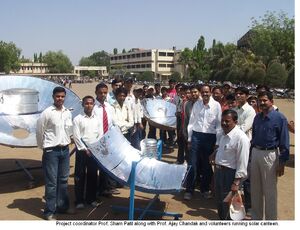
Ajay Chandak and volunteers running solar canteen.
- March 21, 2009: Energy Day was celebrated in a unique way in city of Dhule, India, by a voluntary organization PRINCE (Promoters & Researchers In Non Conventional Energy). With the help of around 100 students of mechanical engineering from SSVPS BSD College of Engineering a solar canteen was set up by Prof. Ajay Chandak, Prof. Sham Patil and Prof. Deepak Dubey. Three SK-14, solar dish cooker, one square PRINCE design of dish cooker and one Community solar cooker of 2.3 m dia. were used in the canteen. On these gadgets almost 1000 snacks were cooked and sold by the students. Staff and students of the Institute and invited guests from the city enjoyed solar food. Guests had fun watching the food being cooked in front of their eyes in the solar cookers and to taste the same as any other methods of cooking. Snacks cooked and sold on large scale were Idlis and coffee. However other snacks like Khichadi, Cakes etc. were also prepared for demonstration to the visitors. Many students, staff and visitors showed great interest in the solar cooking demonstrations and local manufacturer, M/s Essential Equipments, reported sell of around ten solar cookers in next two days, which is welcome outcome of such event. Many students were thrilled with the experience of this event for the first time in their life and have shown great interest to organize such events at different locations in the city, next year. Principal of the Institute Dr. Jahagirdar has promised to support such events in future. Other programs for energy day celebrations included demonstrations of energy efficient technologies for lighting, fans and domestic appliances. All these equipments were demonstrated to visitors. Many visitors reported having changed their copper and aluminum ballasts with electronic ballasts in next week. After all seeing is believing. One workshop was also organized for local masons, hoteliers and interested people to teach them skills of installation of biogas plants working on food waste. Chairperson of PRINCE, Prof. Ajay Chandak, has given up LPG since last four years and fuel requirement for his family comes up from the solar cookers and biogas plant working on food waste. PRINCE group has come up with a special cost effective design of biogas plant. After the workshop five people have shown interest in installation of the biogas plants.
- March 21, 2009: Energy Day in Mumbai
- March 1-3, 2009: Workshop on Entrepreneurship in Renewable Energy" with special emphasis on manufacturing parabolic solar cookers in Dhule, India. More information.
- December 2008: One hundred solar cookers donated to the Barli Development Institute for Rural Women by the Terra Foundation
- November 2008: Priests are urging organizers of community Durga Puja festivals in and around Kolkata to “go green” according to an article in India’s national newspaper The Hindu. They hope to reduce the amount of plastic serving dishes and utensils used during the festivals, and are promoting the use of solar cookers to prepare rice offerings to Devi Durga. The West Bengal Renewable Energy Development Agency will give out awards to puja organizers for use of renewable energy and incorporation of energy efficiency techniques.
- January 14–16, 2009: International Solar Food Processing Conference 2009 in Indore, India
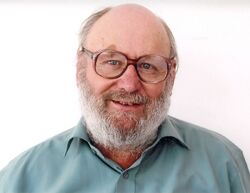
Jimmy McGilligan awarded OBE by Queen Elizabeth II
- November 2008: Jimmy McGilligan, Manager of Barli Development Institute for Rural Women originally from Northern Ireland received his medal, OBE an honour bestowed by her Majesty the Queen Elizabeth II of the United Kingdom at Windsor Castle during investiture ceremony on November 11. “For his services to social causes and the use of alternative energy in rural communities in India”, is the recognition of his dedicated service to the rural and tribal women in central India.
- October 2008: To commemorate the birth anniversary of former Prime Minister of India Mr. Rajiv Gandhi, which is celebrated as “Rajiv Gandhi Renewable Energy Day”. On the occasion, members of Inner Wheel Club of Pune Middtown provided a live demonstration of Solar cooker was demonstrated by roasting peanuts and snacks to the students and dignitaries of the Education department of Pune Municipal Corporation. The students realised the advantages of Solar energy and were delighted They shared their feedback on the occasion.
- August 2008: Dr. Satyapriya Mukhopadhyay, author of the book “Solar Cookere Ranna” and an international adviser to Solar Cookers International, conducted a solar cooker demonstration and seminar on solar cooking and its usefulness at Srikrishna College in March. The awareness-generation program was organized by National Service Scheme (NSS) of Srikrishna College unit. In attendance were nearly 250 students, as well as all college staff and a significant number of local community members. Mukhopadhyay, with the help of NSS program officers and volunteers, used a variety of solar cookers to cook several solar dishes: rice, mutton curry, spicy onion fish, tomato sauce, cazu nut, Indian porridge, dal, and boiled eggs. Shri Arun Kanti Saha, ex-principal and head of mathematics, and Dr. Sankar Prasad Dey, post-doctoral fellow and head of chemistry, delivered lectures on solar concentrating systems and their domestic and industrial uses. According to Dey, “The local participants and students became highly encouraged and showed their interest for generating awareness about solar cooking among the local people. After the completion of this program, organizations … are frequently requesting to Dr. Mukhopadhyay for conduction such program so that they can adopt the technique for cooking their daily foods. From discussions with local people, it is obvious that the program will go a long way towards creation of awareness of the villagers.”

Suryakiran box cooker
- August 2008: Under the brand name SuryaKiran, Universal Engineers Enterprise has manufactured approximately 15,000 box-type solar cookers for various governmental nodal agencies and private sector clients in India since 1996, according to the company’s Chief Manager Neeraj Kumar Garg. The box cookers are tested, approved and certified by the Ministry of New and Renewable Energy (MNRE) and carry the Bureau of Indian Standards ISI mark. They are constructed with fiber-reinforced plastic (FRP) or aluminum bodies, and have a solar-electric hybrid option. Universal Engineers Enterprise also sells parabolic-type solar cookers, along with a variety of solar lighting and water heating systems.
- August 2008: India’s northern state of Haryana won a nation award for its 2002-2007 solar cooker program. The honor was presented to the Department of Renewable Energy and the Haryana Renewable Energy Development Agency (HAREDA) by President Pratibha Devisingh Patil at a ceremony in New Delhi last November. HAREDA promotes solar cookers statewide and provides subsidies to women wishing to purchase solar cookers. Concentrator-type (or dish-type) solar cookers with a diameter of 1.4 meters retail for approximately 5,100 Rupees (Rs), but are available for 2,100 Rs after combined subsidies from national and state agencies. Solar box cookers sell for approximately 1,800 Rs, and are available for 1,300 Rs after subsidies. According to PunjabNewsline.com, 6,329 dish-type and 1,983 box-type solar cookers were distributed in Haryana during the five year period. Reports by the Ministry of New and Renewable Energy (MNRE) show a total of 70,978 solar cookers distributed across India during that time period. For more information about the solar cooker program in Haryana visit www.hareda.gov.in/thermal.htm
- March 2008: A March 2007 white paper — by Dr. Veerabhadran Ramanathan, distinguished professor of climate and atmospheric sciences at the Scripps Institution of Oceanography, University of California, San Diego (USA), and Dr. Kalpana Balakrishnan, head of the Environmental Health Engineering department at Sri Ramachandra University, Chennai, India — outlines a project to reduce air pollution and global warming with community-wide use of solar cookers and improved biofuel cooking devices. The authors provide many referenced details about the negative health and environmental impacts of biomass burning and biofuel cooking, which they say are “the major sources of elemental carbon (EC) in India and other developing nations.” Carbon dioxide and EC, or soot, are the “two largest agents of global warming.” In India, where a reported 90 percent of cooking is done over wood- and dung-fueled fires, several studies have documented that “indoor air pollution leads to 400,000-550,000 premature deaths … from lower respiratory infections and chronic obstructive pulmonary disease. … The burden falls disproportionately on women and children, who inhale soot and other particles from smoke released by the burning of biofuels.” This soot combines with outdoor air pollution to form atmospheric brown clouds (ABCs) that “envelope most of India and the Indian Ocean … [leading] to a large reduction of sunlight at the ground and … atmospheric solar heating.” Since EC and other particles in ABCs have relatively short lifetimes compared to carbon dioxide in the atmosphere, the authors believe global EC reductions can “give us a decade or two to come up with viable and sustainable alternatives for fossil fuel combustion.” In the proposed “Project Surya,” solar cookers will be distributed in 65 villages in the Periyar PURA region in the Thanjavur and Pudukkottai districts of Tamil Nadu, benefiting approximately 6,500 households that currently use about 5 kilograms of firewood per day. Other fuel-efficient cooking devices will be available for use at night or on inclement days. The region has a strong base of local nongovernmental organizations and social networks, including women’s self-help groups, that will be useful for project implementation. Input and feedback from the communities will be gathered and used in a number of ways. Surveys of eating habits and estimated cooking fuel requirements will be conducted. Meetings with local leaders will be used to demonstrate a range of solar cooking technologies and to solicit feedback on their suitability and probability of acceptance in the communities at large. Educational outreach and incentives will be used to maximize use of clean cooking technologies. Installation, operation and maintenance training programs will be offered for those interested. Data collection will begin six months before the project launch, and will continue for at least a year after. Using special instrument towers, researchers will measure concentrations of particulates and soot content, as well as surface solar radiation. If feasible, indoor air pollution will be monitored using special equipment installed in select homes. (Alternatively, a mobile laboratory may be used.) Children will be involved as well, collecting data on cooking fuel use and cooking times, among other things. This data will help quantify the reduction in biofuel use and soot emissions. Though the authors state “it is difficult and costly to [accurately] quantify the disease burden due to indoor air pollution,” they “propose to build the evidence for expected health improvements … through documentation of exposure reduction and subsequently through reduction in incidence and severity of diseases.” The stated goals of the project, in order of importance, are: 1. To eliminate the detrimental health effects of indoor smoke; 2. To reduce the negative effects of EC in ABCs on the summer monsoon rainfall, Himalyan glacier retreat and agriculture; 3. To mitigate the global warming effects of CO2 and elemental carbon. Contact: Vanessa A. Balta Cook, Center for Clouds, Chemistry and Climate at SIO-UCSD. Tel: 858-534-8815, e-mail: vbaltacook@ucsd.edu, Web: Sun Shine Energy

The new 2.3 meter parabolic Community cooker ready for operation
- November 2007: Professor Ajay Chandak, of Promoters and Researchers in Non-Conventional Energy (Prince India), reports completion of an ambitious project to manufacture, transport, install and commission over 300 large parabolic solar cookers at tribal schools in the Indian state of Maharashtra. The project was coordinated by Chandak, with manufacturing by PRINCE trainees M/s Essential Equipments and three contractual manufacturers. Twenty-five trained teams carried out installation and testing of the cookers. The entire process took just 45 days, and resulted in 100 schools being equipped. The Community solar cookers, as Chandak refers to them, are 2.3 meters in diameter and powerful enough for a 22-liter pressure cooker. Each cooker cost around Rs. 26,000 ($650) and comes with a large pressure cooker and other accessories.
- October 2007: Finally the awareness to harness Solar energy and use it to cut costs and save money has arrived in Mumbai. Cut Cost Technologies have introduced the Fuel-Free Cooker in Mumbai, INDIA. Surprisingly its use, in Mumbai, is going to be pioneered by an NGO which is already at the fore-front of adopting renewable energy Sources. The Fuel Free Cooker is an addition to their other renewable energy exploitation. They already have in place solar water heaters and a bio gas plant. Surely more will follow the example of this NGO and save money by cutting costs....because the money saved will be used for the larger good of the society.
- April 2007: Fair Fabricators has been honored for its "outstanding performance" in India’s solar cooker program. The award was sponsored by the governmental Ministry of Non-Conventional Energy Sources (MNES). Fair Fabricators reports that it has manufactured and sold more than 100,000 solar cookers in the last two decades. The company is a leading manufacturer of aluminum-bodied solar box cookers, but also manufactures parabolic-type solar cookers and expects to begin production of solar box cookers made of fiber-reinforced polymer (FRP). Contact: Fair Fabricators
- April 2007: Sankha Subhra Datta has designed a solar box cooker that is suspended at two points within a support frame, allowing for rotation of the entire cooker around a horizontal axis from 5 to 70 degrees with respect to the ground. The cooker can therefore maintain a nearly 90-degree angle to the light as the sun's position in the sky changes. The cooker is rotated around a horizontal axis by repositioning a bar that is attached to the lower front corners of the box between any of 14 slots spread across the base of the frame. Datta says this system has advantages over solar box cookers with tilt-adjusting rear legs — a greater range of rotation can be achieved, and the cook can rotate the unit smoothly without having to lift its entire weight and risk food spillage. Another design feature that helps to prevent food spills is the weighted, rotating cooking tray that keeps the pot horizontal at all times. Regardless of cooker rotation, the pot is always at the center of the cooker because the tray rotates on the horizontal axis of the pot. "This tray holding arrangement is designed for proper utilization of top and bottom reflectors at every inclination … which is not possible in simply suspended tray arrangements [because] shifting of pot location from the central position of the inner box due to the rotation of pot around pivots," Datta says. The cooker frame sits on casters for easy rotation around the vertical axis. The outer box is constructed of galvanized iron and the inner box is aluminum, with glass wool insulation in between. The glazing is double-paned glass with a two-centimeter air gap.
- February 2007: New Delhi, IPS article Indoor Air Pollution - Silent Killer of Women Over 1.5 million females die prematurely every year by inhaling poisonous fumes as they cook or heat their homes...
- November 2006: Rural Development Trust, a nonprofit organization near Chennai, has assembled 30 solar box cookers and distributed them to villages in the area for demonstrations and awareness creation. The Trust has prepared simple Tamil-language instructions on how to build a solar cooker and use it to cook common dishes like rice and lentils.

Snow-capped mountains can be seen in the background of the solar cooking system
- November 2006: An article by M.A. Siraj, appearing in the November/December 2005 issue of Refocus magazine, highlights a solar cooking system installed by Gadhia Solar Energy Systems for the Indian Army. Here is an excerpt: "The Indian Army has commissioned a giant solar cooking system at Leh in the state of Jammu and Kashmir. Located in the Ladakh region at 4,000 meters, it is said to be the world’s highest altitude solar cooking system with the capacity to prepare food for 500 army personnel. Mr. Deepak Gadhia of Gadhia Solar Energy Systems … [said] this was one of the most challenging projects undertaken by his company as the team had to work in extremely adverse climate conditions such as snow, cold winds and sub-zero temperatures. … Prior to solar cooking being introduced, the army kitchen at this base was using nearly 50 kilograms of liquefied petroleum gas and 70 liters of diesel each day to cook food. Described as an icy desert, the region has no vegetation and hence no firewood. Diesel and gas cylinders are transported by air for the Army and the tribal population. The solar cooking system has halved the consumption of these fuels. Gadhia says the heat is generated by five pairs of 9.5 square meter parabolic reflectors which produce steam that is piped down to the kitchen for cooking purpose." Due to the cold climate, the system requires thick pipe insulation, and must be regularly drained of water when not in use.

Professor Ajay Chandak accepts a renewable energy award from Mr. Vinay Kore, the Maharasthra state minister for non-conventional energy, as other dignitaries look on
- November 2006: Professor Ajay Chandak of Promoters and Researchers In Non-Conventional Energy (PRINCE) won a "Renewable Energy Award 2005" from the Maharashtra Energy Development Agency. Of the state-level award for excellence in renewable energy, Prof. Chandak says, "Such awards are small milestones on our way and keep us pushing forward." He thanks friends from around the world for their contributions, adding, "They are equal partners in the award." Contact: Professor Ajay Chandak, Prince India
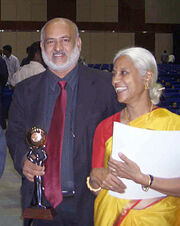
Deepak (left) and Shirin Gadhia
- August 2006: Deepak and Shirin Gadhia, of Gadhia Solar Energy Systems, were awarded the "Business Leadership Award 2005 for Solar Thermal" at the annual International Congress on Renewable Energy (ICORE) in Hyderabad last February. The award was received from the Solar Energy Society of India (SESI), a member of the International Solar Energy Society (ISES). "Like all pioneering work, initially the path had been a slow, up-hill process," said the Gadhias. "But now, due to ever increasing energy costs and environmental catastrophes like global warming, it makes mankind realize that clean, renewable, sustainable technologies are the best possible option." Upon winning the award, the Gadhias acknowledged Dr. Dieter Seifert and Wolfgang Scheffler, whose solar concentrator cooking technologies are promoted by Gadhia Solar.
- August 2006: Solar Alternatives and Associated Programmes (SAAP) is a nonprofit, charitable society committed to environmental protection and empowerment of the downtrodden through solar energy applications, particularly solar thermal technologies. Run by the Jesuits, and led by Fr. M.M. Mathew, SAAP conducts research, development, fabrication and installation of a variety of solar devices, including household solar cookers, community solar cookers, solar steam cooking systems, and solar food dryers. They have even developed a solar chapatti cooker. Many of SAAP's devices rely on solar concentrator technologies developed by Dr. Dieter Seifert and Wolfgang Scheffler, and the Solar Bruecke organization. SAAP empowers socially and economically depressed groups through employment opportunities as fabricators, as well as vocational training programs affiliated with the National Institute of Open Schools. Contact: Solar Alternatives and Associated Programmes
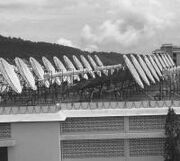
Solar steam cooking system mounted atop Tirumala Tirupati Devasthanam
- March 2006: Representatives from hotels and educational institutions gathered recently in Tirupati, Andhra Pradesh, to learn about solar concentrating systems for steam generation that can cook thousands of meals daily. Representatives from other industries that could benefit from solar steam generation also attended. The meeting was organized by the Non-Conventional Energy Development Corporation of Andhra Pradesh (NEDCAP) and sponsored by the Ministry of Non-Conventional Energy Sources (MNES). Mr. Deepak Gadhia, Managing Director of Gadhia Solar, detailed how solar concentrating systems work and mentioned several industrial uses in addition to cooking: incineration, waste water evaporation, solar desalination, solar air conditioning and solar space heating, to name a few. Two testimonials were provided. First, Mr. Malliah, Vice President of Sanghi Employee Welfare Association, told of how he attended a lecture by Mr. Gadhia a few years earlier and was convinced that his organization needed to install such a system, given that they are always looking at ways to reduce costs, improve efficiencies and protect the environment. Their system, which cost about $12,500 after a 50% government subsidy, is working well. Costs were recouped within two years. Next, Mr. Kachwaha told of a system that was installed in a silk processing plant. Not only did this system reduce energy costs, but it also reduced noise and air pollution within the plant, resulting in a better work environment and greater productivity. The system has since been repurposed from solar steam generation to solar water heating, with a daily capacity of 1600 liters. After the gathering, participants toured the world’s largest solar steam cooking system at Tirumala Tirupati Devasthanam. The system is comprised of 106 rooftop-mounted parabolic concentrators that generate steam for cooking up to 30,000 meals daily. The gathering was covered in a number of newspapers and appeared on television news stations. Contact: Jagadeeswara Reddy
- January 2006: Professor Ajay Chandak of Promoters & Researchers In Non-Conventional Energy (PRINCE) led a workshop titled “Manufacturing Parabolic Solar Cookers and an introduction to renewable energy technologies.” Twenty people from eight states participated in the workshop, mostly renewable energy professionals. Mr. Chandak hopes that several of them will consider manufacturing parabolic solar cookers in their own states. Large community-size cookers, two meters or more in diameter, proved quite popular. These cookers can cook meals for 30-50 people. Smaller, family-side cookers were also shown, as were related technologies like solar food dryers. Contact: Ajay Chandak, Prince India


